William Westmoreland
William Childs Westmoreland (March 26, 1914 – July 18, 2005) was a United States Army general, most notably commander of United States forces during the Vietnam War from 1964 to 1968. He served as Chief of Staff of the United States Army from 1968 to 1972.
William Westmoreland | |
|---|---|
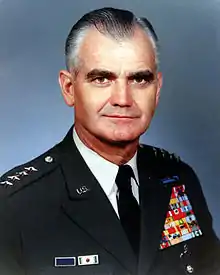 Westmoreland in 1969 | |
| Nickname(s) | "Westy" |
| Born | March 26, 1914 Saxon, South Carolina, U.S. |
| Died | July 18, 2005 (aged 91) Charleston, South Carolina, U.S. |
| Buried | West Point Cemetery |
| Allegiance | United States |
| Service/ | |
| Years of service | 1936–1972 |
| Rank | General |
| Service number | 0-20223 |
| Commands held | Chief of Staff of the United States Army Military Assistance Command, Vietnam XVIII Airborne Corps United States Military Academy 101st Airborne Division 187th Regimental Combat Team 504th Parachute Infantry Regiment 34th Field Artillery Battalion |
| Battles/wars | World War II Korean War Vietnam War |
| Awards | Army Distinguished Service Medal (4) Legion of Merit (3) Bronze Star Medal |
Westmoreland adopted a strategy of attrition against the Viet Cong and the North Vietnamese Army, attempting to drain them of manpower and supplies. He also made use of the United States' edge in artillery and air power, both in tactical confrontations and in relentless strategic bombing of North Vietnam. Nevertheless, public support for the war eventually diminished, especially after the Battle of Khe Sanh and the Tet Offensive in 1968. By the time he was re-assigned as Army Chief of Staff, United States military forces in Vietnam had reached a peak of 535,000 personnel. Westmoreland's strategy was ultimately politically unsuccessful. Growing United States casualties and the draft undermined United States support for the war, while large-scale casualties among non-combatants weakened South Vietnamese support. This also failed to weaken North Vietnam's will to fight, and the Government of South Vietnam—a factor largely out of Westmoreland's control—never succeeded in establishing enough legitimacy to quell defections to the Viet Cong.
Early life
William Childs Westmoreland was born in Spartanburg County, South Carolina, on March 26, 1914 to Eugenia Talley Childs and James Ripley Westmoreland. His upper middle class family was involved in the local banking and textile industries. At the age of 15, William became an Eagle Scout in his Boy Scouts of America (BSA) local council's Troop 1, and was recipient of the Distinguished Eagle Scout Award and Silver Buffalo from the BSA as a young adult. After spending a year at The Citadel in 1932,[1] he was appointed to attend the United States Military Academy on the nomination of Senator James F. Byrnes, a family friend.[2] His motive for entering West Point was "to see the world". He was a member of a distinguished West Point class that also included Creighton Abrams and Benjamin O. Davis Jr. Westmoreland graduated as First Captain—the highest cadet rank—and received the Pershing Sword, which is "presented to the cadet with highest level of military proficiency".[3][4][5] Westmoreland also served as the superintendent of the Protestant Sunday School Teachers.[6]
Military career
Following graduation from West Point in 1936, Westmoreland became an artillery officer and served in several assignments with the 18th Field Artillery at Fort Sill. In 1939, he was promoted to first lieutenant, after which he was a battery commander and battalion staff officer with the 8th Field Artillery at Schofield Barracks, Hawaii.
World War II
In World War II, Westmoreland saw combat with the 34th Field Artillery Battalion, 9th Infantry Division, in Tunisia, Sicily, France, and Germany; he commanded the 34th Battalion in Tunisia and Sicily.[7] He reached the temporary wartime rank of colonel, and on October 13, 1944, was appointed the chief of staff of the 9th Infantry Division.[8]
1945–1952
After the war, Westmoreland completed paratrooper training at the Army's jump school in 1946. He then commanded the 504th Parachute Infantry Regiment, 82nd Airborne Division. From 1947 to 1950, he served as chief of staff for the 82nd Airborne Division. He was an instructor at the Command and General Staff College from August to October 1950 and at the newly organized Army War College from October 1950 to July 1952.[9]
Korean War
From July 1952 to October 1953, Westmoreland commanded the 187th Airborne Regimental Combat Team in Japan and Korea.[9] He was promoted to brigadier general in November 1952 at the age of 38, making him one of the youngest U.S. Army generals in the post-World War II era.[10]
1953–1964
After returning to the United States in October 1953, Westmoreland was deputy assistant chief of staff, G–1, for manpower control on the Army staff until 1955.[9] In 1954, Westmoreland completed a three-month management program at Harvard Business School. As Stanley Karnow noted, "Westy was a corporation executive in uniform."[11] From 1955 to 1958, he was the United States Army's Secretary of the General Staff. He then commanded the 101st Airborne Division from 1958 to 1960. He was Superintendent of the United States Military Academy from 1960 to 1963. In 1962, Westmoreland was admitted as an honorary member of the Massachusetts Society of the Cincinnati. He was promoted to lieutenant general in July 1963 and was Commanding General of the XVIII Airborne Corps from 1963 to 1964.
Vietnam War: Background and overview
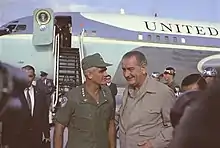
The attempted French re-colonization of Vietnam following World War II culminated in a decisive French defeat at the Battle of Dien Bien Phu.[12][13] The Geneva Conference (April 26 – July 20, 1954) discussed the possibility of restoring peace in Indochina, and temporarily separated Vietnam into two zones, a northern zone to be governed by the Việt Minh, and a southern zone to be governed by the State of Vietnam, then headed by former emperor Bảo Đại. A Conference Final Declaration, issued by the British chairman of the conference, provided that a general election be held by July 1956 to create a unified Vietnamese state. Although presented as a consensus view, this document was not accepted by the delegates of either the State of Vietnam or the United States. In addition, China, the Soviet Union and other communist nations recognized the North while the United States and other non-communist states recognized the South as the legitimate government. By the time Westmoreland became army commander in South Vietnam, the option of a Korea-type settlement with a large demilitarized zone separating north and south, favored by military and diplomatic figures, had been rejected by the US government whose objectives were to achieve a decisive victory and not to use vastly greater resources. The infiltration by regular North Vietnam forces into the South could not be dealt with by aggressive action against the northern state because intervention by China was something the US government was concerned to avoid, but President Lyndon B. Johnson had given commitments to uphold South Vietnam against communist North Vietnam.[14][15]

Army Chief of Staff Harold Keith Johnson came to see U.S. goals as having become mutually inconsistent, because defeating the Communists would require declaring a national emergency and fully mobilizing the resources of the US. General Johnson was critical of Westmoreland's defused corporate style, considering him overattentive to what government officials wanted to hear. Nonetheless, Westmoreland was operating within longstanding army protocols of subordinating the military to civilian policymakers. The most important constraint was staying on the strategic defensive out of fear of Chinese intervention, but at the same time President Lyndon B. Johnson had made it clear that there was a higher commitment to defending Vietnam.[16][17] Much of the thinking about defense was by academics turned government advisors who concentrated on nuclear weapons, seen as making conventional war obsolete. The fashion for counter-insurgency thinking also denigrated the role of conventional warfare. Despite the inconclusive outcome of the Korean War, Americans expected their wars to end with the unconditional surrender of the enemy.[15]
The Gulf of Tonkin incident of 2 August 1964 led to a dramatic increase in direct American participation in the war, with nearly 200,000 troops deployed by the end of the year. Viet Cong and PAVN strategy, organization and structure meant Westmoreland faced a dual threat. Regular North Vietnamese army units infiltrating across the remote border were apparently concentrating to mount an offensive and Westmoreland considered this the danger that had to be tackled immediately. There was also entrenched guerrilla subversion throughout the heavily populated coastal regions by the Viet Cong. Consistent with the enthusiasm of Robert McNamara for statistics, Westmoreland placed emphasis on body count and cited the Battle of Ia Drang as evidence the communists were losing. However, the government wished to win at low cost, and policymakers received McNamara's interpretation indicating huge American casualties in prospect, prompting a reassessment of what could be achieved. Moreover, the Battle of Ia Drang was unusual in that US troops brought a large enemy formation to battle. After talking to junior officers General Westmoreland became skeptical about localised concentrated search and destroy sweeps of short duration, because the Communist forces controlled whether there were military engagements, giving an option to simply avoid battle with US forces if the situation warranted it. The alternative of sustained countrywide pacification operations, which would require massive use of US manpower, was never available to Westmoreland, because it was considered politically unacceptable.[16][17][18]
In public at least, he continued to be sanguine about the progress being made throughout his time in Vietnam, though supportive journalist James Reston thought Westmoreland's characterizing of the conflict as attrition warfare presented his generalship in a misleading light.[19] Westmoreland's critics say his successor, General Creighton Abrams, deliberately switched emphasis away from what Westmoreland dubbed attrition. Revisionists point to Abrams's first big operation being a tactical success that disrupted North Vietnamese buildup, but resulted in the Battle of Hamburger Hill, a political disaster that effectively curtailed Abrams's freedom to continue with such operations.[16][17][18]
Commander of Military Assistance Command, Vietnam (MACV)
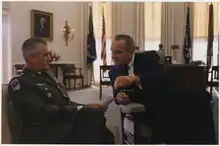
Westmoreland was sent to Vietnam in 1963. In January 1964, he became deputy commander of Military Assistance Command, Vietnam (MACV), succeeding Paul D. Harkins as commander in June. Secretary of Defense Robert McNamara told President Lyndon B. Johnson in April that Westmoreland was "the best we have, without question".[20] As the head of the MACV, he was known for highly publicized, positive assessments of U.S. military prospects in Vietnam. In 1965, TIME named him man of the year.[21] He was mentioned in another Time magazine article as a potential candidate for the 1968 Republican presidential nomination.[22]

As time went on, the strengthening of communist combat forces in the South led to regular requests for increases in U.S. troop strength, from 16,000 when Westmoreland arrived to its peak of 535,000 in 1968 when he was promoted to Army chief of staff. On April 28, 1967, Westmoreland addressed a joint session of Congress. "In evaluating the enemy strategy", he said, "it is evident to me that he believes our Achilles heel is our resolve. ... Your continued strong support is vital to the success of our mission. ... Backed at home by resolve, confidence, patience, determination, and continued support, we will prevail in Vietnam over the communist aggressor!" Westmoreland claimed that under his leadership, United States forces "won every battle".[23] The turning point of the war was the 1968 Tet Offensive, in which communist forces attacked cities and towns throughout South Vietnam. At the time, Westmoreland was focused on the Battle of Khe Sanh and considered the Tet Offensive to be a diversionary attack. It is not clear if Khe Sanh was meant to be distraction for the Tet Offensive or vice versa;[24] sometimes this is called the Riddle of Khe Sanh. Regardless, U.S. and South Vietnamese troops successfully fought off the attacks during the Tet Offensive, and the communist forces took heavy losses, but the ferocity of the assault shook public confidence in Westmoreland's previous assurances about the state of the war. Political debate and public opinion led the Johnson administration to limit further increases in U.S. troop numbers in Vietnam. Nine months afterward, when the My Lai Massacre reports started to break, Westmoreland resisted pressure from the incoming Nixon administration for a cover-up, and pressed for a full and impartial investigation by Lieutenant General William R. Peers. However, a few days after the tragedy, he had praised the same involved unit on the "outstanding job", for the "U.S. infantrymen had killed 128 Communists [sic] in a bloody day-long battle". Post 1969 Westmoreland also made efforts to investigate the Phong Nhị and Phong Nhất massacre a year after the event occurred.[25]
| External video | |
|---|---|

Westmoreland was convinced that the Vietnamese communists could be destroyed by fighting a war of attrition that, theoretically, would render the Vietnam People's Army unable to fight. His war strategy was marked by heavy use of artillery and airpower and repeated attempts to engage the communists in large-unit battles, and thereby exploit the US's vastly superior firepower and technology. Westmoreland's response, to those Americans who criticized the high casualty rate of Vietnamese civilians, was: "It does deprive the enemy of the population, doesn't it?"[26] However, the North Vietnamese Army (NVA) and the National Liberation Front of South Vietnam (NLF) were able to dictate the pace of attrition to fit their own goals: by continuing to fight a guerrilla war and avoiding large-unit battles, they denied the Americans the chance to fight the kind of war they were best at, and they ensured that attrition would wear down the American public's support for the war faster than they.[27]
Westmoreland repeatedly rebuffed or suppressed attempts by John Paul Vann and Lew Walt to shift to a "pacification" strategy.[23] Westmoreland had little appreciation of the patience of the American public for his time frame, and was struggling to persuade President Johnson to approve widening the war into Cambodia and Laos in order to interdict the Ho Chi Minh trail. He was unable to use the absolutist stance that "we can't win unless we expand the war". Instead, he focused on "positive indicators", which ultimately turned worthless when the Tet Offensive occurred, since all his pronouncements of "positive indicators" did not hint at the possibility of such a last-gasp dramatic event. Tet outmaneuvered all of Westmoreland's pronouncements on "positive indicators" in the minds of the American public.[28]
At one point in 1968, Westmoreland considered the use of nuclear weapons in Vietnam in a contingency plan codenamed Fracture Jaw, which was abandoned when it became known to the White House.[29]
Chief of Staff of the United States Army

In June 1968, Westmoreland was appointed by President Lyndon B. Johnson to succeed General Harold K. Johnson as Chief of Staff of the United States Army. Shortly after the Tet Offensive, it was announced that General Creighton Abrams would succeed Westmoreland as commander of the MACV. Although the decision had been made in late 1967, it was widely seen in the media as a punishment for being caught off-guard by the communist assault.
Westmoreland served as Chief of Staff from 1968 to 1972. In 1970, in response to the My Lai Massacre by U.S. Army forces and the subsequent cover-up by the Army chain of command, he commissioned an investigation that compiled a comprehensive and seminal study of leadership within the Army during the Vietnam War demonstrating a severe erosion of adherence to the army's officer code of "Duty, Honor, Country". The report, entitled Study on Military Professionalism,[30] had a profound influence on Army policies, beginning with Westmoreland's decision to end the policy that officers serving in Vietnam would be rotated into a different post after only six months. However, to lessen the impact of this damaging report, Westmoreland ordered that the document be kept on "close hold" across the entire Army for a period of two years and not disseminated to War College attendees. The report became known to the public only after Westmoreland retired in 1972.[31]
Westmoreland tried to make Army life more attractive during the transition to the all-volunteer force by eliminating reveille formations at dawn, allowing beer to be served in mess halls during evening meals, omitting bed check, easing pass policies, and other directives.[32]
Westmoreland's tenure as Chief of Staff ended on June 30, 1972. He was offered the position of Supreme Allied Commander in Europe, but opted to retire on June 30, 1972. He was awarded the Army Distinguished Service Medal by President Richard Nixon.[9]
Later years
Westmoreland ran unsuccessfully for Governor of South Carolina as a Republican in the 1974 election. He published his autobiography the following year. Westmoreland later served on a task force to improve educational standards in the state of South Carolina.
In 1986, Westmoreland served as grand marshal of the Chicago Vietnam Veterans parade. The parade, attended by 200,000 Vietnam veterans and more than half a million spectators, did much to repair the rift between Vietnam veterans and the American public.[33][34]
Westmoreland versus CBS: The Uncounted Enemy
Mike Wallace interviewed Westmoreland for the CBS special The Uncounted Enemy: A Vietnam Deception. The documentary, shown on January 23, 1982, and prepared largely by CBS producer George Crile III, alleged that Westmoreland and others had deliberately understated Viet Cong troop strength during 1967 in order to maintain U.S. troop morale and domestic support for the war. Westmoreland filed a lawsuit against CBS.
In Westmoreland v. CBS, Westmoreland sued Wallace and CBS for libel, and a lengthy legal process began. Just days before the lawsuit was to go to the jury, Westmoreland suddenly settled with CBS, and they issued a joint statement of understanding. Some contend that Judge Leval's instructions to the jury over what constituted "actual malice" to prove libel convinced Westmoreland's lawyers that he was certain to lose.[35] Others point out that the settlement occurred after two of Westmoreland's former intelligence officers, Major General Joseph McChristian and Colonel Gains Hawkins, testified to the accuracy of the substantive allegations of the broadcast, which were that Westmoreland ordered changes in intelligence reports on Viet Cong troop strengths for political reasons. Disagreements persist about the appropriateness of some of the methods of CBS's editors.[36]
A deposition by McChristian indicates that his organization developed improved intelligence on the number of irregular Viet Cong combatants shortly before he left Vietnam on a regularly scheduled rotation. The numbers troubled Westmoreland, who feared that the press would not understand them. He did not order them changed, but instead did not include the information in reporting to Washington, which in his view was not appropriate to report.
Based on later analysis of the information from all sides, it appears clear that Westmoreland could not sustain a libel suit because CBS's principal allegation was that he had caused intelligence officers to suppress facts. Westmoreland's anger was caused by the implication of the broadcast that his intent was fraudulent and that he ordered others to lie.
During the acrimonious trial, Mike Wallace was hospitalized for depression, and despite the legal conflict separating the two, Westmoreland and his wife sent him flowers. Wallace's memoir is generally sympathetic to Westmoreland, although he makes it clear he disagreed with him on issues surrounding the Vietnam War and the Nixon Administration's policies in Southeast Asia.
Views on Vietnam War
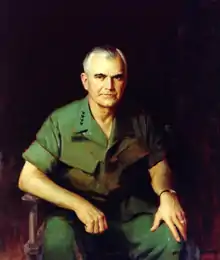
In a 1998 interview for George magazine, Westmoreland criticized the battlefield prowess of his direct opponent, North Vietnamese general Võ Nguyên Giáp. "Of course, he [Giap] was a formidable adversary", Westmoreland told correspondent W. Thomas Smith Jr. "Let me also say that Giap was trained in small-unit, guerrilla tactics, but he persisted in waging a big-unit war with terrible losses to his own men. By his own admission, by early 1969, I think, he had lost, what, a half million soldiers? He reported this. Now such a disregard for human life may make a formidable adversary, but it does not make a military genius. An American commander losing men like that would hardly have lasted more than a few weeks." In the 1974 film Hearts and Minds, Westmoreland opined that "The Oriental doesn't put the same high price on life as does a Westerner. Life is plentiful, life is cheap in the Orient. And as the philosophy of the Orient expresses it: Life is not important."[37]
Westmoreland's view has been heavily criticized by Nick Turse, the author of the book Kill Anything That Moves: The Real American War in Vietnam. Turse said that many of the Vietnamese killed were actually innocent civilians, and the Vietnamese casualties were not just caused by military cross-fire but were a direct result of the U.S. policy and tactics, for example the policy "kill everything that moves" which enabled the U.S. soldiers to shoot civilians for "suspicious behavior". He concluded that, after having "spoken to survivors of massacres by United States forces at Phi Phu, Trieu Ai, My Luoc and so many other hamlets, I can say with certainty that Westmoreland's assessment was false". He also accused Westmoreland of concealing evidence of atrocities from the American public when he was the Army Chief of Staff.[38]
In more than a decade of analyzing long-classified military criminal investigation files, court-martial transcripts, Congressional studies, contemporaneous journalism and the testimony of United States soldiers and Vietnamese civilians, I found that Gen. William C. Westmoreland, his subordinates, superiors and successors also engaged in a profligate disregard for human life.
— Nick Turse[38]
Historian Derek Frisby also criticized Westmoreland's view during an interview with Deutsche Welle:
General William Westmoreland, who commanded US military operations in the Vietnam War, unhesitatingly believed Giap was a butcher for relentlessly sacrificing his soldiers in unwinnable battles. Yet, that assessment in itself is key to understanding the West's failure to defeat him. Giap understood that protracted warfare would cost many lives but that did not always translate into winning or losing the war. In the final analysis, Giap won the war despite losing many battles, and as long as the army survived to fight another day, the idea of Vietnam lived in the hearts of the people who would support it, and that is the essence of "revolutionary war".
— Derek Frisby[39]
For the remainder of his life, Westmoreland maintained that the United States did not lose the war in Vietnam; he stated instead that "our country did not fulfill its commitment to South Vietnam. By virtue of Vietnam, the U.S. held the line for 10 years and stopped the dominoes from falling."
Personal life
Westmoreland first met his future wife, Katherine (Kitsy) Stevens Van Deusen, while stationed at Fort Sill; she was nine years old at the time and was the daughter of the post executive officer, Colonel Edwin R. Van Deusen. Westmoreland met her again in North Carolina when she was nineteen and a student at University of North Carolina at Greensboro. The couple married in May 1947 and had three children: a daughter, Katherine Stevens; a son, James Ripley II, and another daughter, Margaret Childs.[40][41][42]
Just hours after Westmoreland was sworn in as Army Chief of Staff on July 7, 1968, his brother-in-law, Lieutenant Colonel Frederick Van Deusen (commander of 2nd Battalion, 47th Infantry Regiment), was killed when his helicopter was shot down in the Mekong Delta region of Vietnam.[43]
Westmoreland died on July 18, 2005, at the age of 91 at the Bishop Gadsden retirement home in Charleston, South Carolina. He had suffered from Alzheimer's disease during the final years of his life. He was buried on July 23, 2005, at the West Point Cemetery, United States Military Academy.[44]
The General William C. Westmoreland Bridge in Charleston, South Carolina, is named in his honor.[45]
In 1996, the National Society of the Sons of the American Revolution (SAR) authorized the General William C. Westmoreland award. The award is given each year in recognition to an outstanding SAR veterans volunteer.[46]
William Westmoreland was inducted as a Laureate of The Lincoln Academy of Illinois and awarded the Order of Lincoln (the state's highest honor) by the governor of Illinois in 1970 in the area of Government.[47]
Major military assignments
- Commander, 34th Field Artillery Battalion, 9th Infantry Division; 1943–1944
- Chief of Staff, 9th Infantry Division; October 13, 1944 to 1946
- Commander, 504th Parachute Infantry Regiment, 82d Airborne Division; 1946 to 1947
- Chief of Staff, 82d Airborne Division; 1947 to 1950
- Instructor, Army Command and General Staff College; 1950 to 1951
- Student, Army War College; 1951
- Instructor, Army War College; 1951 to November 1952
- 187th Airborne Regimental Combat Team; November 1952 to 1953
- Deputy Assistant Chief of Staff, G–1, for Manpower; 1953 to 1955
- Secretary of the General Staff; 1955 to 1958
- Commanding General, 101st Airborne Division; 1958 to 1960
- Superintendent, United States Military Academy; 1 July 1960 to 27 June 1963
- Commanding General, XVIIIth Airborne Corps; July 1963 to December 1963
- Deputy Commander, United States Military Assistance Command Vietnam; January 1964 to June 1964
- Commander, United States Military Assistance Command Vietnam; June 1964 to June 1968
- Chief of Staff, United States Army; July 3, 1968 to June 30, 1972
Military awards
Westmoreland's military awards include:[48]
.svg.png.webp) Master Parachutist Badge Master Parachutist Badge |
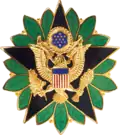 Army Staff Identification Badge Army Staff Identification Badge |
| Army Distinguished Service Medal with three bronze oak leaf clusters[49] | |
| Legion of Merit with two Oak Leaf Clusters | |
| Bronze Star Medal | |
| Air Medal with nine Oak Leaf Clusters | |
| Army Presidential Unit Citation | |
| American Defense Service Medal with one bronze service star | |
| American Campaign Medal | |
| European-African-Middle Eastern Campaign Medal with seven service stars | |
| World War II Victory Medal | |
| Army of Occupation Medal with "Germany" clasp | |
| National Defense Service Medal with oak leaf cluster | |
| Korean Service Medal with two 3⁄16" bronze stars | |
| Vietnam Service Medal with six 3⁄16" bronze stars |
- Foreign decorations and awards
Other awards
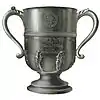 Knox Trophy Award, USMA highest military efficiency as a cadet at West Point, 1936.
Knox Trophy Award, USMA highest military efficiency as a cadet at West Point, 1936.
Dates of rank
![]() United States Military Academy class of 1936
United States Military Academy class of 1936
| Second Lieutenant (Regular Army) |
First Lieutenant (Regular Army) |
Major (Army of the United States) |
Lieutenant Colonel (Army of the United States) |
Colonel (Army of the United States) |
|---|---|---|---|---|
| O-1 | O-2 | O-4 | O-5 | O-6 |
| 12 June 1936 | 12 June 1939 | 1 February 1942 (temporary) |
25 September 1942 (temporary) |
28 July 1944 (temporary) |
| Captain (Regular Army) |
Major (Regular Army) |
Brigadier General (Army of the United States) |
Lieutenant Colonel (Regular Army) |
Major General (Army of the United States) |
|---|---|---|---|---|
| O-3 | O-4 | O-7 | O-5 | O-8 |
| 12 June 1946 | 15 July 1948 | 7 November 1952 (temporary) |
7 July 1953 | December 1956 (temporary) |
| Colonel (Regular Army) |
Brigadier General (Regular Army) |
Major General (Regular Army) |
Lieutenant General (Army of the United States) |
General (Army of the United States) |
|---|---|---|---|---|
| O-6 | O-7 | O-8 | O-9 | O-10 |
| June 1961 | 14 July 1962 | 20 May 1963 | 31 July 1963 (temporary) |
1 August 1964 (temporary) |
Citations
- "William Westmoreland". Biography.com. Archived from the original on 2017-10-08. Retrieved 2017-10-07.
- Whitney, Craig R.; Pace, Eric (20 July 2005). "William C. Westmoreland Is Dead at 91; General Led U.S. Troops in Vietnam". The New York Times. Retrieved 14 May 2017.
- "Finding Aid for Papers (ca. 1900–2005) of General William Childs Westmoreland" (PDF). University of South Carolina.
- "Papers of Gen. William Westmoreland (USCS Autumn 1999)". University of South Carolina. Archived from the original on 2008-07-24. Retrieved 2008-02-01.
- "Obituary: General William Westmoreland". The Independent. Retrieved 2008-02-01.
- 1936 Howitzer Yearbook.
- "Field Artillery Unit History & Links". angelfire.com.
- Headquarters Morning Report, 13 Oct 1944, Division Headquarters, 9th Infantry Division. Available on microfilm at National Personnel Records Center, St. Louis, Missouri. (Entry reads: "O-20223 Westmoreland, William C Col, Reld fr asdg HQ 9 Inf Div Arty & asgd to Div Hq 9 Inf Div per par 1, SO 241 HQ 9 Inf Div dtd 12 Oct 44. Joined 12 Oct 44. Detailed in G.S.C. per par 2, GO 87 Hq 9 Inf Div dtd 12 Oct 44. Primary Duty: Chief of Staff".)
- "William Childs Westmoreland Papers—General William Childs Westmoreland Timeline". University of South Carolina Collection. Retrieved November 6, 2021.
- Zaffiri, Samuel (1994). Westmoreland: A Biography of General William C. Westmoreland. William Morrow and Company: William Morrow and Company. p. 81. ISBN 978-0-688-14345-9.
At thirty-eight, he was one of the youngest generals in the Army.
- Stanley Karnow. Vietnam: A History. p. 361.
- Nguyễn Anh Thái; Nguyễn Quốc Hùng; Vũ Ngọc Oanh; Trần Thị Vinh; Đặng Thanh Toán; Đỗ Thanh Bình (2002). Lịch sử thế giới hiện đại (in Vietnamese). Ho Chi Minh City: Giáo Dục Publisher. pp. 320–22. 8934980082317.
- Flitton, Dave. "Battlefield Vietnam – Dien Bien Phu, the legacy". Public Broadcasting System PBS. Archived from the original on 2021-11-17. Retrieved 29 July 2015.
- Westmoreland's War: Reassessing American Strategy in Vietnam, Gregory Daddis, p. 74
- Conversations with History: Institute of International Studies, UC Berkeley Harry Kreisler of the Institute of International Studies and Colonel Harry G. Summers
- The Ia Drang Campaign 1965: A Successful Operational Campaign or Mere Tactical Failure?, Peter J. Schifferle (1994)
- Sorley, Lewis (February 17, 1998). "To Change a War: General Harold K. Johnson and the PROVN Study". United States Army War College Press. Retrieved November 6, 2021.
- Westmoreland: The General who Lost Vietnam By Lewis Sorley p96
- Westmoreland's War: Reassessing American Strategy in Vietnam, Gregory Daddis, pp. 74-75
- "The Best in the Army". Presidential Recordings Program. Archived from the original on 2014-02-21. Retrieved 16 March 2013.
- Ollove, Michael (April 28, 1995). "Derided Westmoreland led losing effort in Vietnam, but still refuses to retreat TATTERED IMAGES". Archived from the original on June 22, 2021. Retrieved November 5, 2021.
- "The Temper of the Times". Time. 1967-04-14. Archived from the original on November 4, 2007. Retrieved 2007-09-14.
- Sheehan, Neil (1988). A Bright Shining Lie: John Paul Vann and America in Vietnam.
- Willbanks, James H. The Tet Offensive: A Concise History. Columbia University Press, 2007, pp. 104–09
- Kim Chang-seok (2000-11-15). ""한국군도 많이 당했다" 채명신 전 주월한국군총사령관 인터뷰… 남베트남군 사령관 만나 사과한 적도". Hankyoreh. Retrieved 2011-02-06.
- Murray Kempton, "Heart of Darkness," New York Review of Books, 24 Nov. 1988, p. 26
- Thompson, Mark (30 September 2011). "The General Who Lost Vietnam". Time – via time.com.
- McPherson, Harry. "Vietnam, a television history: Tet (1968) minute 3:24". PBS. Archived from the original on 2015-05-25. Retrieved 4 December 2014.
- Sanger, David E. (October 6, 2018). "U.S. General Considered Nuclear Response in Vietnam War, Cables Show". The New York Times. Retrieved 2018-10-08.
- "Study on Military Professionalism". US Army War College. 30 June 1970. Archived from the original on 29 September 2013. Retrieved 19 Oct 2015.
- Ricks, Thomas E (30 Oct 2012). "20". The Generals: American Military Command from World War II to Today. The Penguin Press. ISBN 978-1594204043.
- Schmidt, Dana Adams (December 9, 1970). "Westmoreland Mutes Reveille Bugler". The New York Times. Retrieved November 5, 2021.
- "Vietnam Veterans In Chicago Parade Cheered By Crowds". The New York Times. June 14, 1986.
- At peace, at last after 11 years and an emotional parade, Vietnam vets finally feel welcome Archived 2012-11-06 at the Wayback Machine. Chicago Tribune. August 17, 1986.
- The Tet Offensive: Intelligence Failure in War. Cornell University Press. 1994. ISBN 0801482097. Retrieved 2007-11-13.
- "Mike Wallace". Museum of Broadcast Communications. Archived from the original on 2009-07-25. Retrieved 2007-11-13.
- Quỳnh Phạm; Himadeep Muppidi (2013). "Wrestling the Frame". In Blaney, David L.; Tickner, Arlene B. (eds.). Claiming the International. Abingdon: Routledge. p. 179. ISBN 978-0-415-63068-9.
- Turse, Nick (October 9, 2013). "For America, Life Was Cheap in Vietnam". The New York Times.
- Gabriel Domínguez Vo Nguyen Giap – 'A master of revolutionary war' Deutsche Welle, 07.10.2013
- Whitney, Craig R.; Pace, Eric (2005-07-20). "William C. Westmoreland Is Dead at 91". The New York Times. Retrieved 2011-08-04.
- McLendon, Winzola (1967-05-01). "While the General's at War His Lady Does Hospital Work". The Milwaukee Sentinel. Retrieved 2013-10-05.
- "Gen. William Childs Westmoreland Papers, ca. 1900–2000 (Gifts to Manuscripts Division 2001, South Caroliniana Library)". University of South Carolina. Retrieved 2013-10-05.
- "Westy In-law Dies in Viet". Pacific Stars and Stripes. 6807PSS.AVN, 68070399.KIA. 1968-07-07. Retrieved 2007-09-14.
- "General William Westmoreland, Friend of ASA, Dies". American Sportscasters Online. 1991-05-31. Retrieved 2011-08-04.
- "South Carolina General Assembly 109th Session, 1991–1992, Bill 918". South Carolina Senate. 1991-05-31. Retrieved 2010-08-16.
- "General William C. Westmoreland Award". National Society of the Sons of the American Revolution. 2009-10-14. Archived from the original on 2011-08-13. Retrieved 2011-08-04.
- "Laureates by Year – The Lincoln Academy of Illinois". The Lincoln Academy of Illinois. Retrieved 2016-03-07.
- Hearing Before the Committee On Armed Services United States Senate Ninetieth Congress Second Session on Gen. William Chils Westmoreland, Army of the United States, for Appointment as Chief of Staff, U.S. Armyy Ernest Louis Massad, of Oklahoma to be Deputy Assistant Secretary of Defense for Reserve Affairs Robert C. Moot, of Virginia, to be an Assistant Secretary of Defense. Washington, DC: U.S. Government Printing Office. 1968. p. 2. Retrieved 24 February 2020.
- "Military Times Hall of Valor". Archived from the original on 2021-11-23. Retrieved 2011-08-03.
- "The Crown Council of Ethiopia". Crown Council of Ethiopia. Archived from the original on 2012-12-26. Retrieved 2007-09-23.
- "General William Westmoreland Uniform – UNIFORMS [REF] USA". Archived from the original on 2018-09-20. Retrieved 2011-08-03.
- Ille, Dr Maureen L. [Westmoreland]. "Biography General William Childs Westmoreland". westmoreland-worldwide.org.uk. Archived from the original on 2012-03-28. Retrieved 2011-08-05.
Cited and general references
- Karnow, Stanley (1991), Vietnam: A History, New York: Penguin, ISBN 978-0140265477.
- Mascaro, Tom (1982), The Uncounted Enemy: A Vietnam Deception, Chicago: The Museum of Broadcast Communications.
- Smith, W. Thomas Jr. (November 1998), "An old soldier sounds off", George, New York.
- Wallace, Mike; Gates, Gary Paul (2005), Between You and Me, New York: Hyperion, ISBN 978-1401383565.
- Westmoreland, William C. (1976), A Soldier Reports, Garden City, New York: Doubleday, ISBN 978-0385004343.
External links
- General
- Appearances on C-SPAN
- Westmoreland's political donations
- An article on the CBS documentary controversy by LTC Evan Parrott for the Air War College
- PDF copies of MG McChristian's deposition for the CBS trial
- A biography on William Westmoreland at Encyclopaedia Britannica
- MG McChristian's deposition concerning his participation in the documentary and clarifying his observation of the facts
- Analysis of the broadcast by Professor Peter Rollins of Oklahoma State University, hosted on Vietnam Veterans website
- William C. Westmoreland Collection US Army Heritage and Education Center, Carlisle, Pennsylvania
- 1981 video interview with Westmoreland about U.S. military involvement in Vietnam
- William Westmoreland at Find a Grave
- Commanding Generals and Chiefs of Staff (PDF; pp. 146–147): Army biography, a publication of the United States Army Center of Military History
- Obituaries
- Initial report on the death of Westmoreland from the Associated Press
- Obituary: General Commanded Troops in Vietnam from The Washington Post
- Gen. Westmoreland, Who Led U.S. in Vietnam, Dies from The New York Times
- Commander of US forces in Vietnam dies aged 91 from The Times
- A general who fought to win from The State
- 'Westy' recalled as noble, tragic from The State
- Farewell salute to a fine soldier from The Washington Times
- General Westmoreland's Death Wish and the War in Iraq from CommonDreams.org

